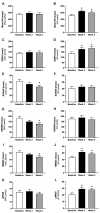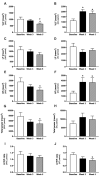Acupuncture Improves Heart Rate Variability, Oxidative Stress Level, Exercise Tolerance, and Quality of Life in Tracheal Collapse Dogs
- PMID: 35202341
- PMCID: PMC8875848
- DOI: 10.3390/vetsci9020088
Acupuncture Improves Heart Rate Variability, Oxidative Stress Level, Exercise Tolerance, and Quality of Life in Tracheal Collapse Dogs
Abstract
Among the respiratory disorders in dogs from small breeds, tracheal collapse is one of the most commonly found in clinical practice. Presently, acupuncture is widely used as an alternative treatment which was shown to bring about positive effects in the treatment of human respiratory diseases. The present study demonstrated the effect of acupuncture on tracheal collapse dogs. We hypothesized that acupuncture can help dogs suffering from tracheal collapse by improving various parameters including heart rate variability, serum biomarkers for oxidative stress, exercise performance, and quality of life. Twenty client-owned dogs from small breeds with tracheal collapse disease were enrolled. The study was divided into two 5-week periods. During the first period, the dogs received normal veterinary care but received no acupuncture treatment (NAC). After completing that period, all forms of treatment were withheld for one week before the beginning of the second period. In the second period, all dogs restarted normal veterinary care and underwent acupuncture treatment (AC) once a week for five consecutive weeks. Blood was collected at the beginning and end of each of the two periods for malondialdehyde (MDA) level measurement. Heart rate variability (HRV) was recorded at the 1st, 3rd and 5th weeks of both periods. Exercise tests were performed at the beginning and end of AC period and questionnaire interviews with the owners were accomplished at the end of each period. The results showed that acupuncture can alleviate clinical signs of tracheal collapse, reduce MDA level, and improve sympathovagal balance. We suggest that acupuncture treatment could be used as an adjunct treatment for canine tracheal collapse.
Keywords: acupuncture; dogs; heart rate variability; tracheal collapse.
Conflict of interest statement
The authors declare no conflict of interest.
Figures



Similar articles
-
Polyunsaturated Fatty Acid EAB-277® Supplementation Improved Heart Rate Variability and Clinical Signs in Tracheal Collapse Dogs.Front Vet Sci. 2022 Jul 14;9:880952. doi: 10.3389/fvets.2022.880952. eCollection 2022. Front Vet Sci. 2022. PMID: 35909680 Free PMC article.
-
Long-term outcome, complications and disease progression in 23 dogs after placement of tracheal ring prostheses for treatment of extrathoracic tracheal collapse.Vet Surg. 2015 Jan;44(1):103-13. doi: 10.1111/j.1532-950X.2014.12206.x. Epub 2014 Jun 7. Vet Surg. 2015. PMID: 24909184
-
Anticoagulant rodenticide toxicosis causing tracheal collapse in 4 small breed dogs.J Vet Emerg Crit Care (San Antonio). 2018 Nov;28(6):573-578. doi: 10.1111/vec.12774. Epub 2018 Oct 7. J Vet Emerg Crit Care (San Antonio). 2018. PMID: 30294908
-
Tracheal collapse.Probl Vet Med. 1991 Jun;3(2):229-38. Probl Vet Med. 1991. PMID: 1802250 Review.
-
Interventional Radiology Management of Tracheal and Bronchial Collapse.Vet Clin North Am Small Anim Pract. 2018 Sep;48(5):765-779. doi: 10.1016/j.cvsm.2018.05.010. Epub 2018 Jun 23. Vet Clin North Am Small Anim Pract. 2018. PMID: 29941216 Review.
Cited by
-
Effect of feeding toy and the presence of a dog owner during the feeding time on dog welfare.Vet World. 2023 Aug;16(8):1721-1726. doi: 10.14202/vetworld.2023.1721-1726. Epub 2023 Aug 24. Vet World. 2023. PMID: 37766708 Free PMC article.
-
Effect of combined Zhuang medicine treatment on tricuspid annular displacement and heart rate variability in rheumatoid arthritis patients.Am J Transl Res. 2024 Jul 15;16(7):2953-2962. doi: 10.62347/NHTG3720. eCollection 2024. Am J Transl Res. 2024. PMID: 39114726 Free PMC article.
-
Differences in Levels of Mitochondrial DNA Content at Various Stages of Canine Myxomatous Mitral Valve Disease.Animals (Basel). 2023 Dec 14;13(24):3850. doi: 10.3390/ani13243850. Animals (Basel). 2023. PMID: 38136887 Free PMC article.
References
-
- Mason A.R., Johnson L.R. Tracheal collapse. In: King L.G., editor. Textbook of Respiratory Disease in Dogs and Cats. W.B. Saunders; Saint Louis, MO, USA: 2004. pp. 346–355. Chapter 46.
LinkOut - more resources
Full Text Sources

